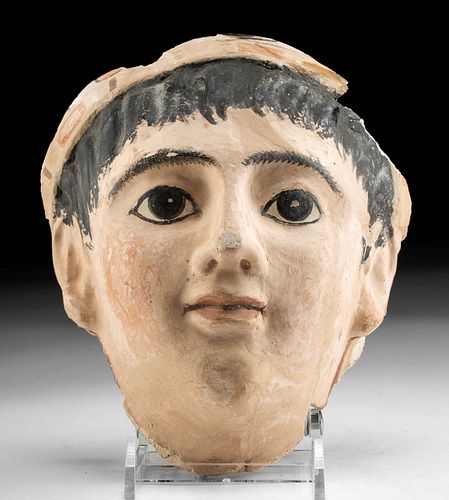Romano Egyptian Stucco Mask of a Young Boy
Lot 23
About Seller
Artemis Fine Arts
686 S Taylor Ave, Ste 106
Louisville, CO 80027
United States
Selling antiquities, ancient and ethnographic art online since 1993, Artemis Gallery specializes in Classical Antiquities (Egyptian, Greek, Roman, Near Eastern), Asian, Pre-Columbian, African / Tribal / Oceanographic art. Our extensive inventory includes pottery, stone, metal, wood, glass and textil...Read more
Estimate:
$5,500 - $6,500
Absentee vs Live bid
Two ways to bid:
- Leave a max absentee bid and the platform will bid on your behalf up to your maximum bid during the live auction.
- Bid live during the auction and your bids will be submitted real-time to the auctioneer.
Bid Increments
| Price | Bid Increment |
|---|---|
| $0 | $25 |
| $300 | $50 |
| $1,000 | $100 |
| $2,000 | $250 |
| $5,000 | $500 |
| $10,000 | $1,000 |
| $20,000 | $2,500 |
| $50,000 | $5,000 |
| $100,000 | $10,000 |
| $200,000 | $20,000 |
About Auction
By Artemis Fine Arts
Jun 10, 2021
Set Reminder
2021-06-10 10:00:00
2021-06-10 10:00:00
America/New_York
Bidsquare
Bidsquare : Exceptional Antiquities | Asian | Ethnographic
https://www.bidsquare.com/auctions/artemis-gallery/exceptional-antiquities-asian-ethnographic-7012
Museum-worthy examples of Egyptian, Greek, Roman, Viking, Near Eastern, Far East / Asian, Pre-Columbian, African / Tribal, Oceanic, Native American, Spanish Colonial, Russian, Fossils, Ancient Jewelry, Fine Art, so much more! Artemis Fine Arts info@artemisfinearts.com
Museum-worthy examples of Egyptian, Greek, Roman, Viking, Near Eastern, Far East / Asian, Pre-Columbian, African / Tribal, Oceanic, Native American, Spanish Colonial, Russian, Fossils, Ancient Jewelry, Fine Art, so much more! Artemis Fine Arts info@artemisfinearts.com
- Lot Description
Egypt, late Romano-Egyptian period, ca. 2nd to 3rd century CE. An impressive stucco mask of a young boy exhibiting an endearing visage painted with fine detail in hues of creamy beige, peach, pink, brown, white, and black. His huge, dark eyes gaze forward beneath sweeping, arched brows, each carefully painted with brushstrokes showing every hair. His naturalistic nose sits above bowed lips, held in a petite smile, as well as a dimpled chin. A thick, black coiffure crowns his head and is topped by an elaborately painted headdress with a pair of ears just below. The skin tone is painted with a variety of colors rather than as a flat, single tone, lending the figure depth and realism. This face was modeled on the true features of the deceased, giving the viewer an opportunity to visualize someone who died 2 millennia ago. A marvelous example of the combination of Egyptian and Roman funerary portraiture with the techniques of Hellenistic painting! Size: 5.75" W x 7" H (14.6 cm x 17.8 cm)
Though an adorable countenance, this handsome vizard bears a somber purpose. Masks like this one would have served to honor the dead and, as such, were typically displayed next to a simple wooden coffin during funeral rites and then buried with the dead. Some scholars posit that Egyptians began to follow traditional Roman mortuary practices during the Romano-Egyptian period as well. In such traditions, these masks would be worn by a family member or actor during the funeral procession then displayed within an aristocratic household throughout the year and worn annually during Parentalia (a 9-day Roman festival in honor of family ancestors).
Plaster masks were quite popular in Egypt, and while they evolved from Egyptian traditions reflecting the adaptation and continuation of iconographic and stylistic characteristics of Egyptian funerary art, masks like this example also reveal the Roman penchant for individualized and naturalistic portraiture. They reflect the profound change that the Greco-Roman world brought to Egypt. The naturalistic depiction of a person's face as a mask or even full head replaced the stylized art of dynastic Egypt, as hieroglyphs and other symbols painted on elaborate sarcophagi fell out of favor and Egyptian mummies were buried with life-like representations rather than the mummiform masks seen in previous periods.
This piece has been searched against the Art Loss Register database and has been cleared. The Art Loss Register maintains the world’s largest database of stolen art, collectibles, and antiques.
Provenance: private Salisbury, Maryland, USA collection; ex-George Beach collection, Michigan, USA, acquired prior to 1980
All items legal to buy/sell under U.S. Statute covering cultural patrimony Code 2600, CHAPTER 14, and are guaranteed to be as described or your money back.
A Certificate of Authenticity will accompany all winning bids.
We ship worldwide and handle all shipping in-house for your convenience.
#163755Professionally repaired from at least 10 pieces with restoration over break lines. Losses to peripheries with evidence of being part of a larger piece. Abrasions to nose. Otherwise, excellent.Condition
- Shipping Info
-
All shipping is handled in-house for your convenience. Your invoice from Artemis Gallery will include shipping calculation instructions. If in doubt, please inquire BEFORE bidding for estimated shipping costs for individual items.
-
- Buyer's Premium



 EUR
EUR CAD
CAD AUD
AUD GBP
GBP MXN
MXN HKD
HKD CNY
CNY MYR
MYR SEK
SEK SGD
SGD CHF
CHF THB
THB













